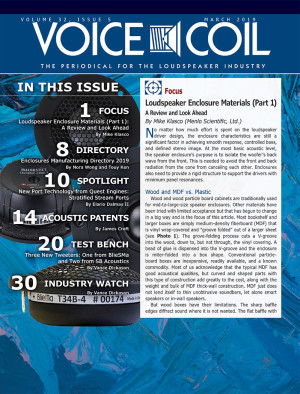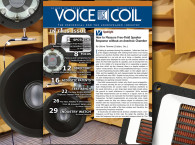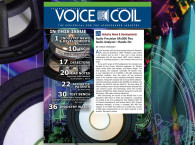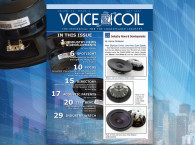 Voice Coil March 2019 is now available and this issue focuses on the vital, but seldom addressed, topic of loudspeaker enclosure materials.
Voice Coil March 2019 is now available and this issue focuses on the vital, but seldom addressed, topic of loudspeaker enclosure materials.
In this edition of Voice Coil, Mike Klasco (Menlo Scientific, Ltd.) reviews and looks ahead at all the materials and design approaches for loudspeaker enclosures. As he writes in the Focus article for this month, "No matter how much effort is spent on the loudspeaker driver design, the enclosure characteristics are still a significant factor in achieving smooth response, controlled bass, and defined stereo image. At the most basic acoustic level, the speaker enclosure’s purpose is to isolate the woofer’s back wave from the front. This is needed to avoid the front and back radiation from the cone from canceling each other. Enclosures also need to provide a rigid structure to support the drivers with minimum panel resonances." This article discusses enclosures using wood, MDF, plastic, plastic composites, moldable materials, coatings and paintings for those materials, while also looking at new cutting-edge bio-plastics materials.
As always, this edition is complemented with a complete global directory of enclosures manufacturing, compiled by Menlo's Nora Wong and Touy Ken. It is a complete resource for manufacturers sourcing vendors in this key area, including suppliers for completely assembled and tested systems and specialized cabinet fabrication.
For this month's Spotlight, Elario Dalmas II (Quest Engines) details how his company's Stratified Stream Ports can improve vented box systems. Quest Engines has developed an innovative patent-pending speaker port technology that allows for new visual and sonic aesthetics in the design of vented box speaker systems, using see-through ports. This new port technology functions using circular wave guides to passively inject air pressure waves generated in the speaker enclosure into the port area. The wave guides direct the air pressure waves into a resonant port with two open ends.
In Acoustic Patents, James Croft (Croft Acoustical) reviews a patented awarded directly to inventors Anthony Allen Bisset (Oakland, CA) and Quang-Viet Nguyen (Aldie, VA), for a Coaxial Centerbody Point-Source (CCPS) Horn Speaker System. The abstract for the patent granted in December, 2018, details a horn-based multi-driver wide-bandwidth loudspeaker with a flat-frequency response having the property of controlled acoustic directivity at wavelengths larger than the nominal wavelength supported by the horns’ mouth circumference, which is provided by means of a center-body fitted with acoustic drivers that are acoustically coupled to the walls of the horn enclosure.
In his review, Croft looks back at multiple multi-driver horn topologies and compares the unique aspects of the CCPS Horn Speaker System, highlighting the positive attributes and benefits of the invention, to deliver both increased acoustic quality and increased power density.
For the March 2019 Test Bench, Vance Dickason characterizes three new tweeters: one from BlieSMa and two from SB Acoustics. The Test Bench starts with the new T34B-4 34mm high-end beryllium dome tweeter from BlieSMa, and proceeds with the new SB Acoustics SB29BNC beryllium 29 mm dome tweeter, and the 29 mm TW29DN-B cloth dome tweeter from the SB Acoustics Satori line of high end devices.
BlieSMa’s first tweeter offering, the T34A-4 34 mm aluminum/magnesium alloy dome, appeared in Voice Coil’s June 2018 Test Bench. The new beryllium driver is the company’s second offering and has a substantial feature set that includes a 34 mm beryllium dome with a 32 kHz first breakup mode, extremely low moving mass for better transient response and higher output, and a fully saturated neodymium motor with copper sleeve shorting ring for low nonlinear and modulation distortion.
The second driver, SB Acoustics' SB29BNC-C000-4 high-end 29 mm beryllium diaphragm neodymium dome is the second of its type to be analyzed in Test bench. Features for this transducer include a small format 72 mm diameter injection-molded plastic faceplate, an 8 mm wide coated cloth surround, a 29 mm beryllium diaphragm, a copper cap on pole piece for reduced voice coil inductance and minimum phase shift, internal pressure equalization and flow resistor for non-resonant coupling of cavities, copper-clad aluminum wound voice coil wire, 0.25 mm Xmax, 95 dB sensitivity, a foam-mounting gasket, and gold-plated terminals.
The last tweeter for this month's Test Bench is also from SB Acoustics, but from the Satori product line. The TW29DN-B-8 is a wide surround format-type similar to the original Vifa DX tweeter, or the current Scan-Speak D2604 or D2607. However, all of these are 26 mm diaphragm tweeters, and the new Satori ST29DN-B-8 is a 29 mm diaphragm type. Features include a 29 mm, 8 mm wide surround coated cloth-type diaphragm, a non-reflective cast-aluminum rear cavity, a two-part aluminum faceplate with integrated mechanical decoupling, dual-balanced compression chambers, a high-saturation neodymium ring type motor magnet with a T-shaped pole and dual copper shorting rings (Faraday shields), a CCAW wound voice coil, foam mounting gasket, and gold-plated terminals.
 Voice Coil March 2019 also includes the usual compilation of important updates for the loudspeaker industry in its Industry Watch section, compiled by Vance Dickason.
Voice Coil March 2019 also includes the usual compilation of important updates for the loudspeaker industry in its Industry Watch section, compiled by Vance Dickason.
This edition is available for download and already in the mail for print subscribers. Subscribers can go to - www.gotomyvcoil.com - to download this issue.
Remember, Voice Coil is available in print and download for all registered subscribers, free for industry professionals. To qualify for a free subscription to Voice Coil, or renew your subscription, go to: audioxpress.com/page/Voice-Coil-Subscriber-Services.html.

- on Magazine News
- News
Expanded Perspectives on Loudspeaker Enclosure Materials with Voice Coil March 2019
February 26 2019, 17:00
Voice Coil March 2019 is now available and this issue focuses on the vital, but seldom addressed, topic of loudspeaker enclosure materials. Mike Klasco reviews and looks ahead at all the materials and design approaches for loudspeaker enclosures, and the edition also includes a complete directory for sourcing vendors in this area. James Croft reviews a Coaxial Centerbody Point-Source (CCPS) Horn Speaker System patent, and Vance Dickason characterizes three new tweeters on Test Bench.







